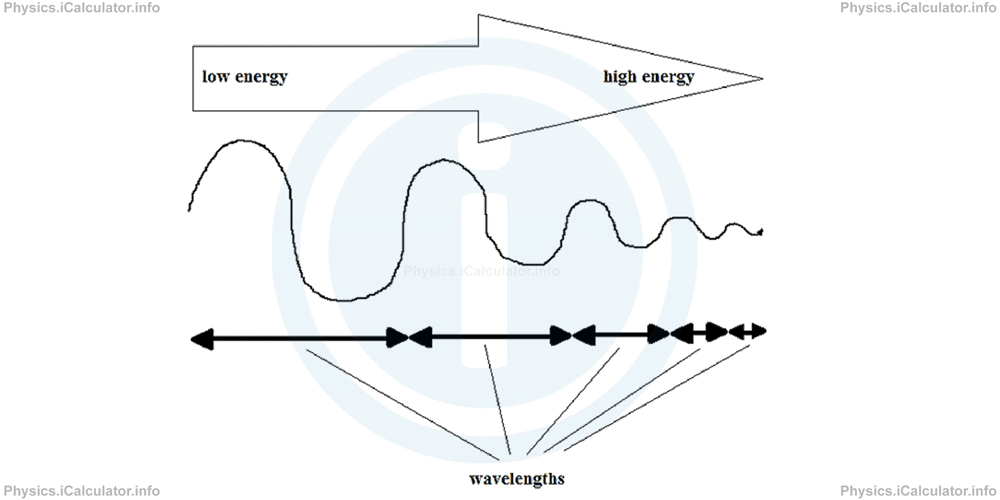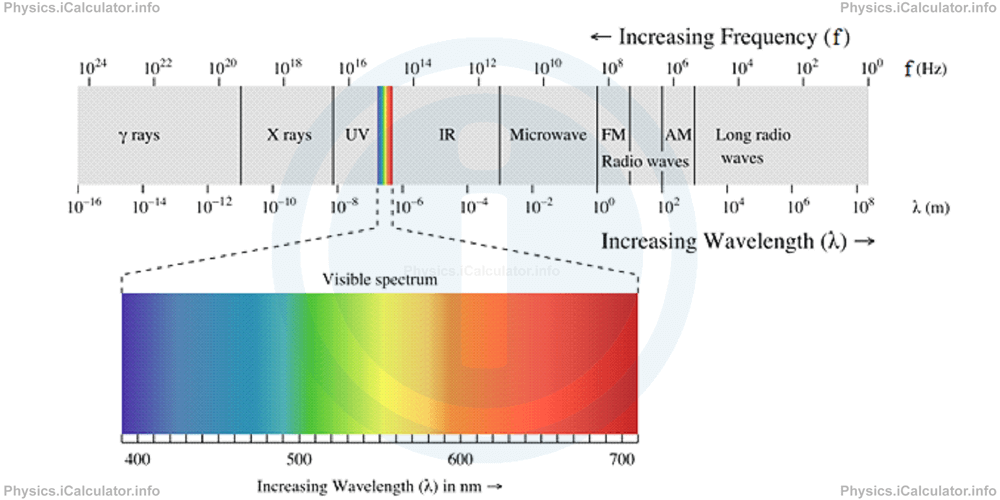Menu
Physics Lesson 11.6.2 - Electromagnetic Spectrum
Please provide a rating, it takes seconds and helps us to keep this resource free for all to use
Welcome to our Physics lesson on Electromagnetic Spectrum, this is the second lesson of our suite of physics lessons covering the topic of Electromagnetic Waves. Light, you can find links to the other lessons within this tutorial and access additional physics learning resources below this lesson.
Electromagnetic Spectrum
The range of EM waves from the shortest to the longest is known as "electromagnetic spectrum". We can classify EM waves from the least powerful to the most powerful (i.e. from the least energetic to the most energetic) based on two criteria:
a) According to the wavelength. In this classification, the first (the least powerful) waves are those with the longest wavelength because it is frequency the quantity which varies directly with energy. Based on the equation of waves where wavelength and frequency are in inverse variation, it is easy to deduce that energy and wavelength are inversely proportional to each other. Look at the figure:

Based on wavelengths, EM waves are classified according to the following subcategories (all values are approximate because the limits in each category are intertwined.
1. Radio waves
These are the least powerful (energetic) waves although their amplitude is the largest. This is because energy varies directly with amplitude but also it varies directly with the square of frequency (i.e. inversely with the square of wavelength). This means frequency (and wavelength) affect the energy of EM waves more than amplitude.
The range of wavelengths for radio waves vary from 106 m to 10-1 m. Radio waves have the advantage of propagation in long distances due to their large amplitude. Therefore, they are mostly used for communication purposes.
2. Micro waves
The range of wavelengths for these waves vary from 10-1 m to 10-5 m. Wi-fi and microwave ovens are examples of microwaves use in technology.
3. Infrared radiation
These waves are perceived as heat. Thus, a hot object emits a lot of IR radiation while a cold object emits less IR radiation. Devices controlled remotely through sensors such as TV remote etc. are all examples of the IR radiation use in technology. Also, thermal cameras which enforce the weak IR radiation emitted by human body to make it visible, are another example of the IR radiation use in technology.
The range of IR radiation wavelength vary from 10-5 m to 7 × 10-7 m (700 nm).
4. Visible light
This is the only part of EM radiation we are able to see at naked eye. The range of wavelengths for visible light is very narrow. It varies from 7 × 10-7 m (700 nm) to 4 × 10-7 m (400 nm). We will discuss in particular about visible light in the our Physics tutorial on the "Features of Light".
5. Ultraviolet radiation
They are EM waves that are more powerful than the visible light, and thus we are not able to see them. (Remember the ultrasounds which are powerful sounds we are not able to hear. This is a similar situation.) Therefore, we must avoid the exposure for long periods in direct sunlight because we cannot see UV radiation falling on our skin, so this may cause harm in our body as they have ability to penetrate the skin layer and burn it. Most UV radiation is filtered by atmosphere (by ozone layer in particular); however, not all UV radiation is filtered, especially in regions where the ozone layer is less dense.
The range of wavelengths for UV radiation varies from 4 × 10-7 m to 10-10 m.
6. X-rays
These are powerful EM waves which we cannot see. X-rays have the ability to penetrate the human tissue; therefore, they are used in imaging technology such as in radiography.
We must avoid the exposure to X-rays as they may cause long-term or permanent damage to our body. A large number of diseases are associated with the harm caused by exposure to radiation.
The range of wavelengths for X-rays varies from 10-10 m to 10-12 m.
7. Gamma (γ) rays
These are the most powerful EM waves. It is absolutely prohibited the exposure even for a short time to these waves as they have the ability to penetrate the entire human body including the bones. Some radioactive elements such as Uranium and Plutonium have the ability to emit gamma radiation by themselves. This is the reason why they are so dangerous.
Gamma rays carry a lot of energy. Therefore, they are used in nuclear reactors to produce energy or nuclear weapons in a controllable way.
The range of wavelengths for γ-rays varies from 10-12 m to 10-16 m.
b)According to the frequency. You can find the corresponding range of frequencies for each category of EM waves based on the equation of waves
where c = constant = 3 × 108 m/s. In this way, you find the following values:
- Radio waves. Since the range of wavelengths for these waves is 10-1 m ≤ λ ≤ 106 m, we obtain for the range of corresponding frequencies (neglecting the constants before the powers of ten): 102 Hz ≤ f ≤ 109 Hz.
- Microwaves. Since the range of wavelengths for these waves is 10-5 m ≤ λ ≤ 10-1 m, we obtain for the range of corresponding frequencies (neglecting the constants before the powers of ten): 109 Hz ≤ f ≤ 1013 Hz.
- Infrared Radiation. Since the range of wavelengths for these waves is 7 × 10-7 m ≤ λ ≤ 10-5 m, we obtain for the range of corresponding frequencies (neglecting the constants before the powers of ten): 1013 Hz ≤ f ≤ 4.5 × 1014 Hz.
- Visible Light. Since the range of wavelengths for these waves is 4 × 10-7 m ≤ λ ≤ 7 × 10-7 m, we obtain for the range of corresponding frequencies (neglecting the constants before the powers of ten): 4.5 × 1014 Hz ≤ f ≤ 7.5 × 1014 Hz.
- Ultraviolet radiation. Since the range of wavelengths for these waves is 4 × 10-7 m ≤ λ ≤ 10-10 m, we obtain for the range of corresponding frequencies (neglecting the constants before the powers of ten): 7.5 × 1014 Hz ≤ f ≤ 1018 Hz.
- X-rays. Since the range of wavelengths for these waves is 10-10 m ≤ λ ≤ 10-12 m, we obtain for the range of corresponding frequencies (neglecting the constants before the powers of ten): 1018 Hz ≤ f ≤ 1020 Hz.
- Gamma rays. Since the range of wavelengths for these waves is 10-12 m ≤ λ ≤ 10-16 m, we obtain for the range of corresponding frequencies (neglecting the constants before the powers of ten): 1020 Hz ≤ f ≤ 1024 Hz.
In the figure below, a double classification of EM waves based on the frequency and wavelength is shown.

Example 2
How many times (at minimum) must a thermal camera enforce the body radiation to make humans visible during the night? Take the average frequency of images a thermal camera can record equal to 5 × 1013 Hz.
Solution 2
A thermal camera must produce images at least at the minimum part of visible light, i.e. images of minimum frequency of 4.5 × 1014 Hz. These images are
more powerful that the real images recorded by the thermal camera. Therefore, such camera must enforce the images by 9 times to make them visible.
You have reached the end of Physics lesson 11.6.2 Electromagnetic Spectrum. There are 2 lessons in this physics tutorial covering Electromagnetic Waves. Light, you can access all the lessons from this tutorial below.
More Electromagnetic Waves. Light Lessons and Learning Resources
Whats next?
Enjoy the "Electromagnetic Spectrum" physics lesson? People who liked the "Electromagnetic Waves. Light lesson found the following resources useful:
- Spectrum Feedback. Helps other - Leave a rating for this spectrum (see below)
- Waves Physics tutorial: Electromagnetic Waves. Light. Read the Electromagnetic Waves. Light physics tutorial and build your physics knowledge of Waves
- Waves Revision Notes: Electromagnetic Waves. Light. Print the notes so you can revise the key points covered in the physics tutorial for Electromagnetic Waves. Light
- Waves Practice Questions: Electromagnetic Waves. Light. Test and improve your knowledge of Electromagnetic Waves. Light with example questins and answers
- Check your calculations for Waves questions with our excellent Waves calculators which contain full equations and calculations clearly displayed line by line. See the Waves Calculators by iCalculator™ below.
- Continuing learning waves - read our next physics tutorial: Diffraction of Waves
Help others Learning Physics just like you
Please provide a rating, it takes seconds and helps us to keep this resource free for all to use
We hope you found this Physics lesson "Electromagnetic Waves. Light" useful. If you did it would be great if you could spare the time to rate this physics lesson (simply click on the number of stars that match your assessment of this physics learning aide) and/or share on social media, this helps us identify popular tutorials and calculators and expand our free learning resources to support our users around the world have free access to expand their knowledge of physics and other disciplines.